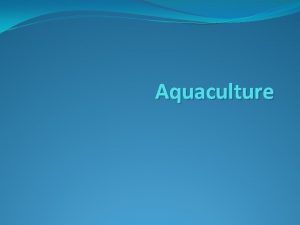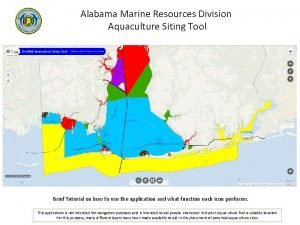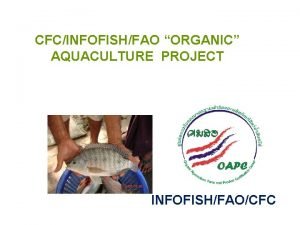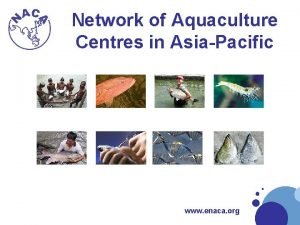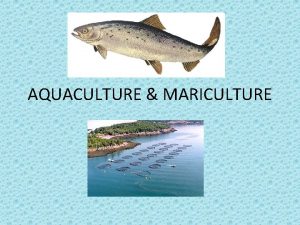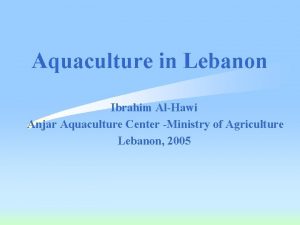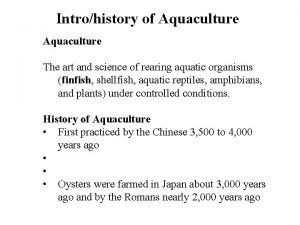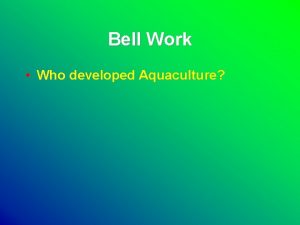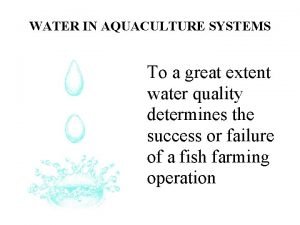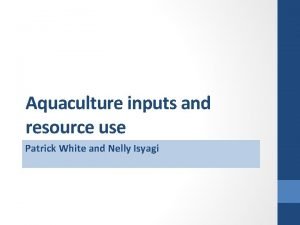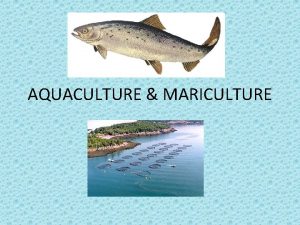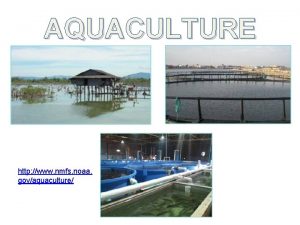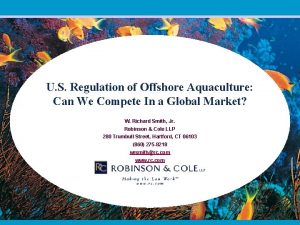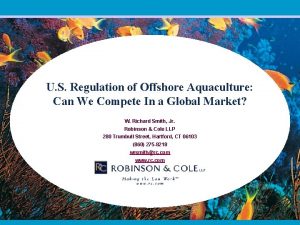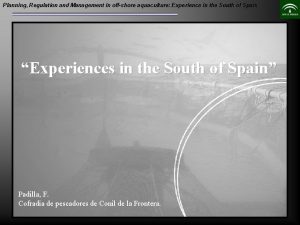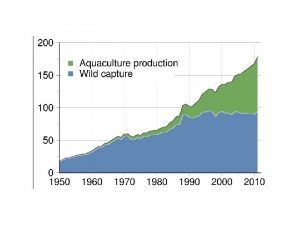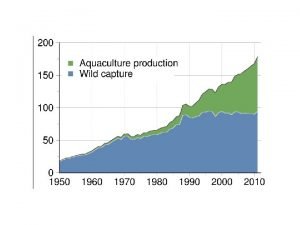U S Regulation of Offshore Aquaculture Can We














- Slides: 14

U. S. Regulation of Offshore Aquaculture: Can We Compete In a Global Market? W. Richard Smith, Jr. Robinson & Cole LLP 280 Trumbull Street, Hartford, CT 06103 (860) 275 -8218 wrsmith@rc. com www. rc. com

Preface • This presentation is intended to facilitate a discussion of the issues presented and does not constitute legal advice. Any questions regarding specific legal issues or facility operations should be reviewed with a lawyer engaged by you for that purpose.

Objective: Produce marketable food fish species in federal waters in compliance with operating standards. Requirements: • Legal right to occupy an EEZ location; • Reasonably obtainable permits and approvals; • Reasonable expectation of continuity; • Reasonable facility operations regulations; • Authority to grow food fish as inventory; and, • Competitive operating costs.

Fish Markets vs. Fish Management • Marketable products defined in regulatory terms: – Right fish (market dictates species); – Right size (reasonable possession controls); – Right time (no season-based restrictions); and, – Right price (competitive production costs).

Some of the Issues to address: • Jurisdictional limits • CWA Discharge permits – which programs apply? • Coastal Zone Management Act standards • Fee issues • Magnuson-Stevens Act (SFA) issues • Other applicable laws issues

1. Jurisdictional limits • Drawing the state-federal lines • Manner of state participation • State regulation in federal waters? – Environmental standards – Other factors • Can states bar federal approvals in EEZ? – Do states get a veto? – Regulation by strangulation – where do you land? – Regulating land operations – range of considerations?

1. Jurisdictional limits cont. • Presidential proclamations and agency rulemaking – Territorial sea – 3 to 12 to 24 n. m. – Contiguous zone and “oceans" definitions – how affected? – Incorporating changes in rulemaking – U. S. C. G. example – Judicial interpretations of specific statutes • Question: did Congress intend a statute to be affected by changes to “territorial sea” definition or other definitions?

2. Discharge permits – which programs apply? • Federal Water Pollution Control Act – effluent limitations guidelines (sec. 402) • Proposed BMPs (2004 due date) • Enforceable BMPs (how – permits? ) • Will Best Professional Judgment cover gaps? • Where do “waters of the US” end? – Did Congress mean 3 miles? – What happens if ELGs don’t apply?

2. Discharge Permits – which programs apply? cont. • Ocean discharge permits and permit criteria – Ocean must mean ocean, correct? – “no unreasonable degradation” or “healthy oceans”? – Sec. 402 vs. 403 (additional or substitute? ) • “Aquaculture discharge permit” (sec. 318 – is it what it says? ) • State regulations – Water quality standards

3. Coastal Zone Management Issues • Impacts evaluations (sec. 307(c)(1)(A)) – What limits for socioeconomic impact analysis? – Do we outlaw consumer-favorable competition or market impacts? • Frustration of federal policy – NOAA’s Year 2025 targets ($5 B products, 600, 000 jobs) – Do we need marine aquaculture, or kill it and move on? – Will a shortage of 4 th grade classrooms stop a fish farm? • Competition between states – Could states oppose offshore facilities in neighboring states?

4. Fee Issues • How to address State or Federal fees? – Minerals vs. mutton snapper? They are not the same. – “Produced” from public lands? Who put products there? – A single model is not appropriate. • Avoiding “payback” approaches? – Aquaculture will not address complaints over range fees.

5. Magnuson-Stevens Act (SFA) Issues • Food fish vs. stock enhancement – is there is a difference? • Should aquaculture remain in “fishing” definition? • Role of FMCs – Veto vs. providing expert comments? – Veto by conditions – death by a thousand cuts? – Aquaculture representation on councils? • Are competition and market impacts proper decision criteria?

6. Other laws applicable to offshore operations • Labor, safety, products liability, environmental standards? • State law, maritime law or new legislation? • Specific laws for aquaculture operations? • Draft NOAA Code of Conduct*: How does it apply? – *”The [Pirate’s] Code is what you call guidelines more than actual rules. ”, Captain Barbossa to Miss Elizabeth Swann in Pirates of the Caribbean – “Codes” vs. “Laws”: do labels matter? – A mandate by any other name.

How could legislation provide solutions? • Maximize legislative answers and reduce uncertainty • Recognize the public policy value of offshore aquaculture • Confirm laws applicable to offshore aquaculture • Resolve potential agency jurisdiction conflicts • Avoid broad and numerous “veto” authorities • Acknowledge the “fish not fees” objective • Create objective standards of approval and operation • Avoid and eliminate duplicative or conflicting federal standards • Don’t leave policy issues to rulemaking or permitting
 What are the objectives of aquaculture
What are the objectives of aquaculture Alabama marine resources division
Alabama marine resources division Raceways aquaculture
Raceways aquaculture Organic tilapia farming
Organic tilapia farming Maksud akuakultur
Maksud akuakultur Network of aquaculture centres in asia-pacific
Network of aquaculture centres in asia-pacific Aquaculture
Aquaculture Example of aquaculture
Example of aquaculture Scope of aquaculture
Scope of aquaculture Aquaculture in lebanon
Aquaculture in lebanon Aquaculture purpose
Aquaculture purpose Bell aquaculture
Bell aquaculture Recirculating aquaculture system
Recirculating aquaculture system Objectives of aquaculture
Objectives of aquaculture Process of aquaculture
Process of aquaculture
